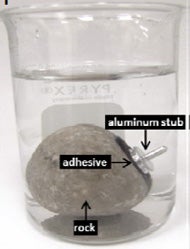Background
In adhesion science, water or moisture has traditionally been treated as surface contaminants or weak boundary layers, since they deteriorate adhesives through a variety of complex mechanisms including erosion, plasticization, swelling, and hydrolysis of adhesive polymers. Contrary to the difficulties faced by man, in the sea, there is a variety of marine organisms capable of adhering to all type of wet surfaces including mussels that stick firmly on rocks, sandcastle worms that live in tubes comprised of sand, shell fragments bonded together with a proteinaceous glue, and barnacles that glue calcareous base plates to rocks and ship bases.
Description of the invention
Our adhesive technology, based on the chemistry of the marine adhesive specialists, can quickly and firmly join two materials together in wet conditions or underwater. The adhesive can work with a wide range of hard and soft materials including polymers, ceramics, and metals with various surface topologies ranging from molecularly smooth to macroscopically rough. The joining process can be carried out entirely in water without pre-treatments of material surfaces. The adhesive, once applied, yields an immediate and reversible adhesion of 20 kPa and achieves a tensile adhesive strength of 40 kPa within 1 hour of curing time, which is enough force to lift a large soft drink bottle (2 L in size) by the area of its cap, and 80 kPa within 2 hours. The adhesion increases overtime resulting a permanent bonding.
Advantages
Our technology uses an innovative approach that allows it to accomplish superior application performance and attain better economy compared to others in the field.
- The technology does NOT require sophisticated chemical synthesis, specific set of skills, or expensive ingredients for fabrication, thus ensuring lower capital investment and cost of production and higher returns and profitability
- It employs a modular design where different adhesive component controls different aspect/behavior of the adhesive, allowing easy engineering of the adhesive, i.e. to control the adhesive’s curing profile and mechanical properties, to meet the need of specific applications
- Compared to others, our adhesive enables in situ fast joining with improved strength, longer durability, and wider applicability
Potential applications
The technology is applicable to adhering, bonding, joining, repairing, patching, and lamination in the manufacture, the marine, and the biomedical industries. Potential applications include but not limited to:
- Repairing of wet tissue
- Patching of leaks (i.e. underwater oil pipe line)
- Underwater constructions

Bonding aluminum stub to a rock with bonding hydrogels in water
Reference
7326
Patent status
Patent issued
Stage of development
Prototype
Contact
Scott Inwood
Director of Commercialization
Waterloo Commercialization Office
sinwood@uwaterloo.ca
uwaterloo.ca/research